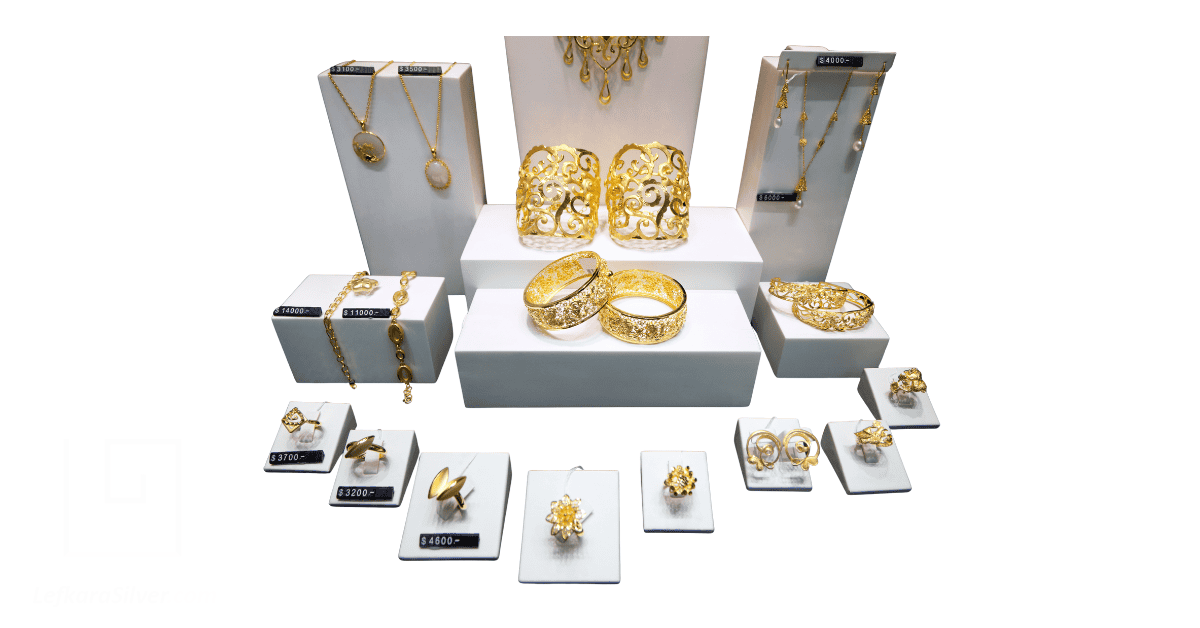
The Beauty Of Filigree Jewelry: Top 10 Picks That’ll Make You Excited in 2025
Ever wondered about jewelry that tells a story, piece by intricate piece? That’s filigree for you! This ancient art form, with its delicate threads of gold and silver twisted into breathtaking patterns, isn’t just about adornment; it’s a whisper of history, a testament to unparalleled craftsmanship, and a bold statement in today’s fashion landscape.
Get ready to dive deep into a world where metal becomes lace and beauty knows no bounds.
The ABCs Of Filigree Jewelry
Filigree is a delicate and intricate form of metalwork that involves twisting thin metal threads, usually gold or silver, and soldering them in artistic patterns. Often resembling lace, these designs are used to create stunning pieces of jewelry that are both airy and elegant. The name itself comes from the Latin words “filum” (thread) and “granum” (grain), which perfectly describes the fine wires and tiny beads used in this ancient technique.
This article will take you on a journey through the captivating world of filigree, exploring its past, present, and future trends. We’ll delve into the nuances of this exquisite craft, covering topics such as:
- Filigree jewelry key statistics
- 2025’s crème de la crème: Top 10 filigree jewelry collections
- The story of vintage filigree jewelry
- Antique filigree jewelry
- Maltese filigree jewelry: An island’s treasure
- The glow of silver filigree jewelry
- Gold filigree jewelry
- Handmade filigree jewelry feels personal
- Explore filigree designs jewelry
- What are filigree jewelry findings?
- Filigree jewelry making techniques: The art behind the art
All the information presented here is the latest as of August 2025, ensuring you’re getting the freshest insights into this enduring art form.
Filigree Jewelry Key Statistics: August 2025

The allure of filigree jewelry is timeless, and its place in the market is backed by some fascinating numbers. Every statistic and fact presented here has been meticulously checked to give you a clear picture of this unique jewelry style’s standing.
- The art of filigree has ancient roots, with the earliest examples dating back over 5,000 years to Mesopotamia.
- The global jewelry market is projected to reach $370 billion in 2025, with intricate styles like filigree contributing to its value.
- Another forecast estimates the global jewelry market size was valued at USD 232.94 billion in 2024 and is projected to grow to USD 242.79 billion in 2025.
- This represents a compound annual growth rate (CAGR) of 5.10% from 2025 to 2032.
- Consumer desire for personalization is a key trend, and 67% of jewelry wearers want pieces that express their personality, a niche where unique filigree designs shine.
- While classic styles are preferred by 44% of consumers, 12% specifically seek out vintage styles, where filigree is a prominent feature.
- Gold remains the dominant metal in jewelry, accounting for 78% of precious metal jewelry sales globally.
2025‘s Crème de la Crème: Top 10 Filigree Jewelry Collections
Finding the perfect piece of filigree jewelry can be a treasure hunt. That’s why we’ve done the legwork for you, curating a list of the best brands and collections out there. The following names were selected based on a cocktail of raving customer reviews, proven reliability, and a consistent offering of high-quality, jaw-dropping filigree jewelry. Get your wish lists ready.
1. Filigree Jewelers
Based in Minneapolis, Filigree Jewelers is a haven for lovers of all things vintage and antique. Their collection is a beautifully curated journey through time, featuring pieces from the Victorian, Edwardian, and Art Deco eras. They specialize in engagement rings but also offer a stunning array of earrings, necklaces, and bracelets. What makes them stand out is their commitment to unique, one-of-a-kind pieces, ensuring you’re getting a slice of history.
2. NOVICA
In partnership with National Geographic, NOVICA provides a global platform for artisans to share their craft. Their filigree collection is a vibrant tapestry of global traditions, featuring handcrafted pieces from artists in places like the Andes and Southeast Asia. Here, you’ll find everything from sterling silver lace-like earrings to intricate gold pendants, each piece telling the story of its creator.
3. Lefkara Silver
For those who adore the bright, cool tones of silver, Lefkara Silver is a must-see. Specializing in traditional Cypriot filigree, their jewelry is 100% handmade using the finest threads of 925 sterling silver. With over 40 years of experience, they employ age-old techniques to create incredibly delicate and flexible designs that are both timeless and contemporary.
4. Antique Jewelry Mall
This online retailer is a treasure trove for anyone specifically seeking antique-style filigree. They offer a massive collection of reproduction filigree jewelry, meticulously crafted to capture the essence of the Edwardian and Art Deco periods. Their rings, often set with diamonds or colorful gemstones like aquamarine and amethyst, are particularly noteworthy for their intricate metalwork and historical accuracy.
5. Portugal Jewels
Portugal has a rich and celebrated history with filigree, and Portugal Jewels brings this tradition to a global audience. They offer an exquisite selection of authentic Portuguese Filigree, including the iconic “Heart of Viana” design. Their pieces are available in 19.2kt gold, 9kt gold, and sterling silver, showcasing a craft that has been passed down through generations of Portuguese artisans.
6. Savara Filigrana
Another gem from Portugal, Savara Filigrana offers a modern take on a centuries-old art form. Their collections are known for integrating contemporary design trends with traditional filigree techniques. This is the place to look for pieces that feel fresh and stylish while still honoring the intricate craftsmanship that defines filigree.
7. Roman Malakov
While known for high-end diamonds and fine jewelry, Roman Malakov also showcases an exceptional appreciation for antique filigree, especially in their engagement ring collections. They are experts in pieces from the Edwardian and Art Deco eras, highlighting how filigree can create settings that are both incredibly detailed and surprisingly durable. Their collection is perfect for those seeking a truly special, heirloom-quality piece.
8. Past Era
Past Era is another specialist in authentic antique and vintage jewelry. Their collection is carefully sourced and authenticated, offering genuine filigree pieces from bygone eras. They provide detailed descriptions of each item’s history and characteristics, making it a fantastic resource for serious collectors and history buffs alike.
9. Viana Jewelry
Handmade in Portugal, Viana Jewelry is dedicated to preserving the art of filigree. They work with local artisans to create collections that are both authentic and accessible. Their designs often feature classic Portuguese motifs, and they are passionate about sharing the stories and techniques behind each piece.
10. Etsy
For a truly diverse and often personalized selection, Etsy is an unbeatable marketplace. It connects you directly with independent jewelers and vintage sellers from around the world. You can find everything from handmade minimalist filigree studs to elaborate antique filigree necklaces. The sheer variety is its biggest strength, allowing you to find a piece that perfectly matches your unique style and budget.
The Story of Vintage Filigree Jewelry
Before we swoon over specific pieces, let’s get our terms straight. “Vintage” isn’t just a buzzword for “old.” In the jewelry world, a piece is typically considered vintage if it’s at least 20 to 30 years old but less than 100. Think of it as a classic film or a fine wine—it’s from a distinct, memorable era.
It’s easy to confuse “vintage” with “antique” and “estate,” but the distinctions are key. Estate jewelry is simply any piece that has been previously owned, regardless of its age. Antique jewelry, the grand dame of the group, is anything over 100 years old. So, all antique jewelry is vintage, but not all vintage jewelry is antique.
Vintage filigree jewelry is a beautiful testament to the enduring appeal of this delicate art form. The 20th century saw filigree flourish in several key periods. The Art Nouveau period (circa 1890-1910) featured flowing, nature-inspired filigree designs. Later, the Art Deco era (1920s-1930s) brought bold, geometric patterns to the forefront, using filigree to create intricate yet structured looks. The value of a vintage filigree piece is determined by its condition, the complexity of its design, the metals and gemstones used, and its historical significance.
When shopping for vintage filigree, it’s wise to be a savvy buyer. Always ask the seller for a detailed description, including the piece’s condition, materials, and any maker’s marks. A reputable seller will be transparent and knowledgeable. Also, don’t forget to check the return policy—it’s your safety net to ensure the piece you receive is the piece you fell in love with online.
Antique Filigree Jewelry
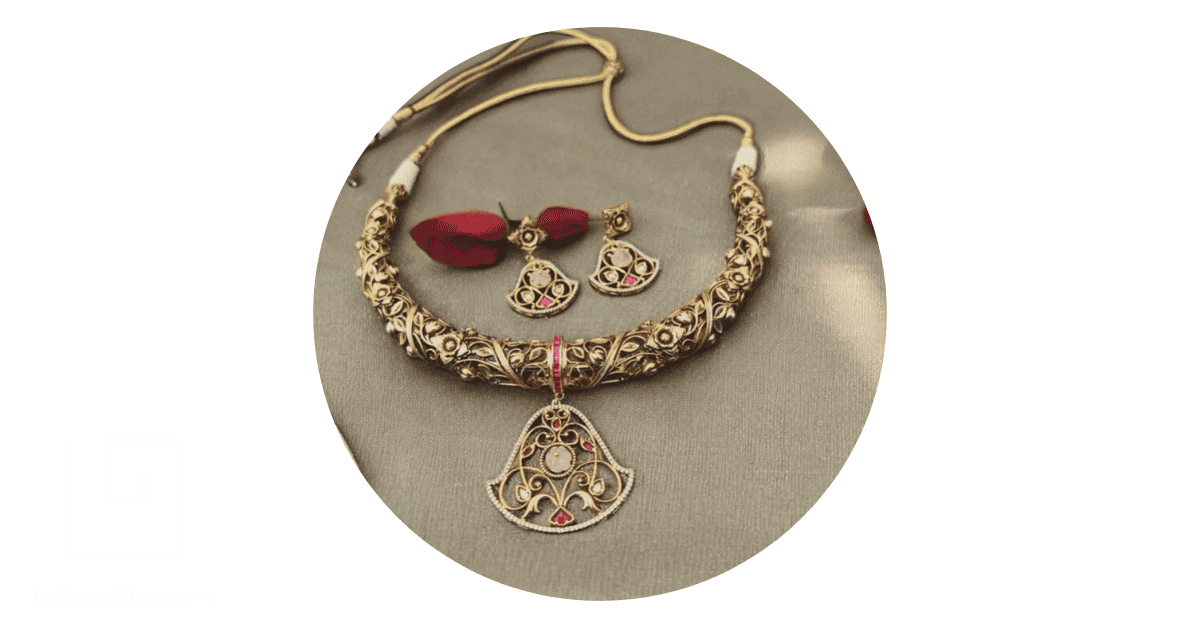
Stepping into the world of antique filigree is like entering a museum of wearable art. To earn the “antique” title, a piece of jewelry must be at least 100 years old. This places these treasures in some of the most romantic and revolutionary periods of design history.
The two eras most celebrated for their breathtaking filigree are the Edwardian period (1901-1910) and the Art Deco period (1920-1935). Edwardian filigree is the epitome of romance and delicacy. Jewelers, newly empowered by the use of platinum, could spin metal into excellent, lace-like designs that were both airy and strong. These pieces often feature motifs like bows, garlands, and scrolls, evoking a sense of lightness and elegance.
Following World War I, the mood shifted, and the Art Deco period emerged with a new, confident energy. Clean lines, geometric shapes, and symmetrical patterns characterize Antique Art Deco filigree. While still intricate, the designs were bolder and more streamlined, reflecting the machine-age modernism of the time.
What makes antique filigree so special is not just its age, but the sheer level of craftsmanship. Every swirl and twist was done by hand by a master artisan. These pieces are tangible links to the past, reflecting the aesthetics and innovations of their time. Despite their delicate appearance, many antique filigree pieces have survived for over a century, a testament to their surprising durability. Owning one isn’t just wearing a piece of jewelry; it’s preserving a piece of history.
Maltese Filigree Jewelry: An Island’s Treasure
Floating in the Mediterranean, the island of Malta holds a glittering secret: a rich and centuries-old tradition of filigree jewelry. This intricate art form has been a gentle, shining star in the local Maltese market for generations. Malta’s filigree legacy can be traced back to the Phoenicians, the ancient seafarers who spread this delicate metalworking technique across the Mediterranean.
Over the centuries, however, local artisans have made the craft distinctly their own. The most iconic and prominent motif you’ll find in Maltese filigree is the eight-pointed Maltese Cross. This powerful symbol is woven into bracelets, earrings, and brooches, appearing in countless variations—sometimes in silver, sometimes in gold, and often embellished with gemstones.
What makes Maltese filigree so captivating is its beautiful marriage of tradition and modernity. While the techniques are ancient, passed down through families, the designs often have a contemporary flair. This makes each piece a perfect blend of old and new, a wearable work of art that carries a piece of Malta’s vibrant cultural heritage.
The Glow of Silver Filigree Jewelry
There’s something effortlessly chic about silver filigree. Its bright, cool luster makes it a wildly popular choice, lending an air of purity and elegance to the intricate, lace-like designs. Whether it’s a pair of dangling earrings or a statement cuff, silver filigree adds a touch of sophistication to any outfit without ever feeling over the top.
The creation of silver filigree is a meticulous dance with metal. It all starts by melting pure silver granules at high temperatures. This molten silver is then poured into molds to create ingots, which are pressed and stretched repeatedly to produce wires of varying thicknesses. The thicker wires form the outer frame of the jewelry, creating the shape, while the gossamer-thin threads are twisted and coiled to create the delicate patterns within.
Fabulous examples can be found in this Filigree Jewelry collection.
To keep your silver filigree looking its best, a little TLC goes a long way. Proper care will maintain its beauty and prevent tarnish.
- For light tarnish, simply mix a few drops of mild dish soap into a bowl of warm water. Let the jewelry soak for a few minutes, then gently clean with a soft brush, rinse with clean water, and pat dry with a soft, lint-free cloth.
- For heavier tarnish, use a commercial silver polish applied with a soft cloth. Rub gently, rinse thoroughly, and dry completely.
- Proper storage is key. Keep your silver filigree in a cool, dry place, ideally in an anti-tarnish bag or a lined jewelry box. Sunlight and humidity are the enemies of shine!
- Remember to take it off! Always remove your silver jewelry before swimming, showering, or using household chemicals, as chlorine and other substances can cause damage.
Gold Filigree Jewelry
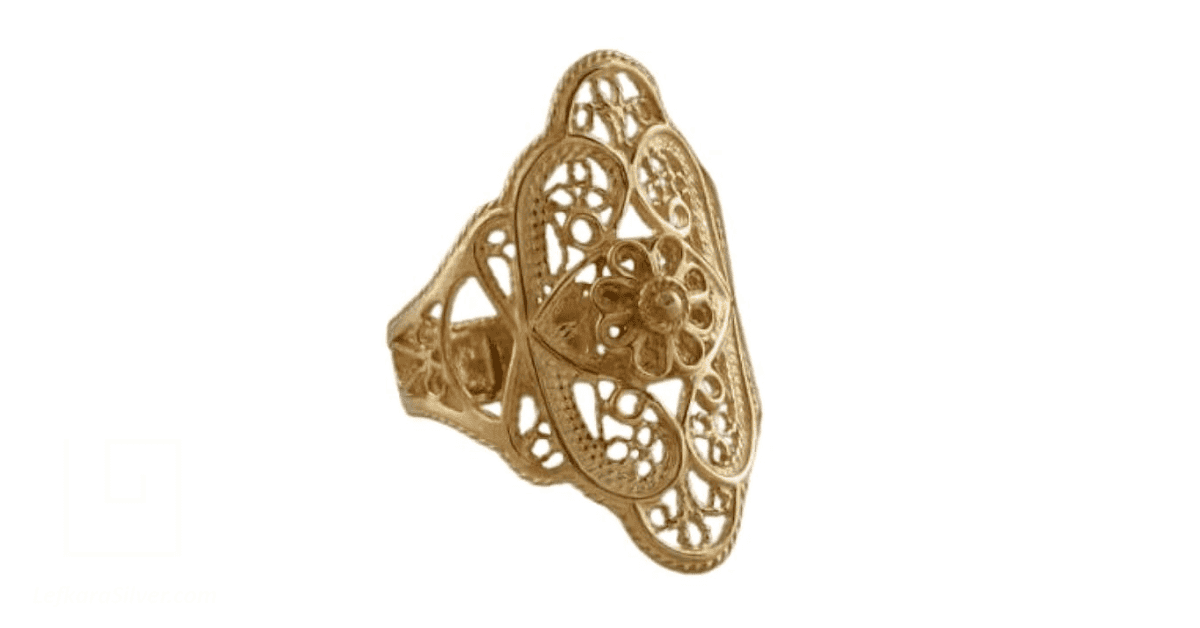
If silver is the cool moonlight, gold filigree is the warm, radiant sun. It brings a touch of opulence and luxury to the delicate art form. The process is much the same—twisting and curling fine threads of gold into intricate patterns—but the result is a rich, warm glow that is undeniably glamorous. Gold filigree jewelry is often adorned with vibrant gemstones, adding an extra layer of luxury and a pop of color.
Choosing between the different types of filigree can come down to personal style and the story you want your jewelry to tell.
Here’s a quick comparison of popular filigree jewelry options:
| Jewelry Type | Material | Notable Features |
|---|---|---|
| Vintage Filigree Jewelry | Varies (often platinum, gold, or silver) | Historical significance, unique designs from specific eras (like Art Deco), and valued for the artisan’s skill. |
| Silver Filigree Jewelry | Sterling Silver | Bright and elegant finish, purity, and often features intricate, airy patterns. |
| Gold Filigree Jewelry | Gold (various karats) | Warm, opulent glow, often paired with gemstones for added luxury, and carries cultural significance in many regions. |
Handmade Filigree Jewelry Feels Personal
In a world of mass production, handmade filigree jewelry is a breath of fresh, artisanal air. It’s a testament to the incredible skill and patience of a craftsperson. A machine doesn’t stamp out these pieces; they are meticulously brought to life, thread by delicate thread of precious metal. The result is a piece of jewelry that feels less like an accessory and more like a personal treasure.
The magic of handmade filigree lies in a few key ingredients:
- Unparalleled Craftsmanship: Every twist, curl, and solder point is done by a human hand. This intricate process, which can take countless hours, results in a level of detail and quality that machines can’t replicate. It’s the tiny, perfect imperfections that give the piece its soul.
- Built-in Uniqueness: Because they are handmade, no two pieces of filigree jewelry are ever identical. This means the earrings you wear or the pendant you choose have a character and charm that is entirely its own. You’re not just buying a design; you’re acquiring a one-of-a-kind work of art.
- Wearable Artistry: Let’s call it what it is: filigree is wearable art. The designs can evoke the delicate patterns of lace, the organic shapes of flowers and vines, or the bold confidence of geometric forms. It’s a showcase of the jeweler’s creativity and artistic vision.
- A Connection to Heritage: Filigree isn’t a new trend; it’s an ancient craft with a rich history spanning cultures all over the globe. Owning a piece of handmade filigree is like holding a piece of that legacy. Brands like Lefkara Silver continue the centuries-old traditions of Cyprus, with their unique offerings in the Silver Jewelry Catalogue, while marketplaces like Etsy and NOVICA connect you with artisans from around the world who are keeping this heritage alive.
Explore Filigree Designs Jewelry
Diving into the world of filigree designs is like looking into a kaleidoscope—the patterns are endless, intricate, and always beautiful. The core of the art is creating detailed designs from fine metal threads, but it’s the arrangement of those threads that truly makes the magic happen. The designs can be anything from whisper-light and elegant to bold and ornate.
Let’s look at a few popular design styles to see just how versatile filigree can be:
- Openwork Filigree: This is perhaps the most classic style. The filigree design is soldered together to create a self-supporting, lace-like pattern with open spaces. This technique creates a wonderfully light and airy effect, allowing you to see through the piece. It’s a true showcase of the artisan’s skill in creating a piece that is both delicate and strong.
- Heart Shape Filigree: A timeless romantic motif, the heart shape is given a vintage and incredibly detailed makeover with filigree. The intricate swirls and curls within the heart frame add a layer of complexity and charm, making these pieces perfect for expressing love and affection.
- Floral Filigree: Nature is a constant source of inspiration, and filigree is the perfect medium to capture the delicate intricacy of flowers and leaves. Floral filigree necklaces and earrings feature petals and vines crafted from twisted metal, creating a look that is both organic and elegant.
- Retro Style Filigree: Drawing inspiration from bygone eras like the Art Deco or Edwardian periods, retro-style filigree often features intricate scrollwork and bold geometric patterns. These designs have a nostalgic feel, perfect for those who love a touch of vintage glamour in their look.
- Filigree Bead Designs: Sometimes the filigree isn’t the whole piece, but a stunning component. Filigree beads are hollow spheres or shapes made from intricate metalwork. These can be strung together to create a bracelet or necklace, or used as beautiful, detailed accents in a larger jewelry design.
What are Filigree Jewelry Findings?
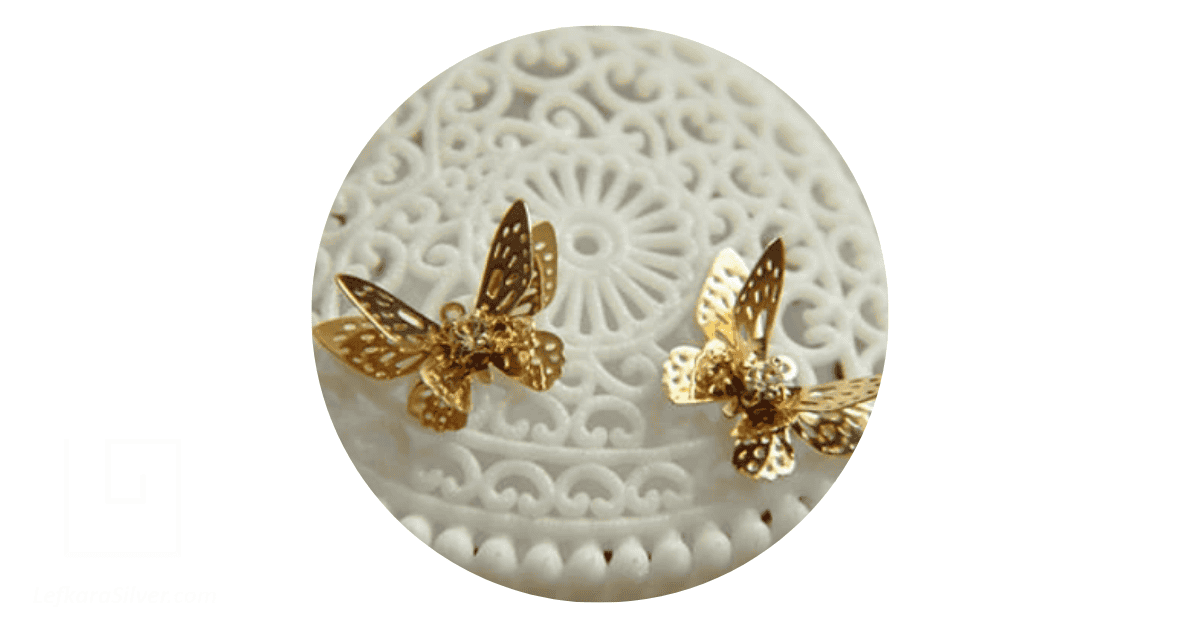
If you’ve ever felt the creative spark to make your own jewelry, you’ve probably encountered “findings.” In a nutshell, findings are the pre-made components that jewelers use to assemble a final piece. Think clasps, ear wires, and bead caps. Filigree jewelry findings, then, are ready-made decorative elements crafted in the filigree style.
These aren’t finished pieces of jewelry, but rather intricate building blocks. They can be anything from delicate filigree connectors and chandelier earring components to elaborate filigree stampings that can be used as the centerpiece of a pendant.
Why are they a top choice for jewelers and DIY enthusiasts? Simple: they provide the incredibly intricate look of filigree without requiring the years of training it takes to master the art from scratch. They are lightweight, versatile, and can instantly elevate a simple design into something spectacular.
You can find high-quality filigree findings at major jewelry supply retailers like Fire Mountain Gems, Rings & Things, and Shipwreck Beads. To ensure you’re getting genuine, good-quality findings, look for a few key things. Check the material description—is it sterling silver, gold-filled, or brass? Reputable sellers will be clear about the metal content. Examine the details: even in a mass-produced finding, the filigree pattern should be crisp and well-defined, not blurry or sloppy. Finally, while they look delicate, the findings should feel sturdy and not bend too easily.
Filigree Jewelry Making Techniques: The Art Behind the Art
Before we dive into how filigree is made, it’s helpful to know the lingo. Filigree jewelry is often assembled from various components, sometimes called “findings.” These are the building blocks that come together to create a finished piece.
| Component | Description |
|---|---|
| Filigree Drops | These are small, often teardrop-shaped decorative elements that can be linked together or used as dangles on earrings and necklaces. |
| Filigree Pendants | Usually the star of the show, these are the larger, more detailed focal points of a necklace or bracelet. |
| Filigree Beads | These are intricate, hollow beads made from filigree that can be strung together or used as beautiful spacers and accents in a larger design. |
Now, let’s pull back the curtain on the incredible artistry required to bring these components to life. The ancient technique of filigree has roots stretching back an astonishing 5,000 years to Mesopotamia. The name itself, a clue to the process, comes from the Latin words filum (thread) and granum (grain), the latter referring to the tiny metal beads often used to accent the designs.
Creating a piece of filigree jewelry is a meticulous, multi-step process that is truly an art form.
- Designing
It all begins with an idea. The jeweler sketches a design, mapping out the intricate patterns and shapes that will eventually be spun from metal. This initial blueprint is the crucial foundation upon which the entire piece is built. - Metal Preparation
Next, thin wires of gold, silver, or sometimes platinum are selected. These aren’t just plain wires; they are often twisted, flattened, or plaited together to create different textures and light-reflecting surfaces. The artisan creates a thicker wire to form the outer frame or skeleton of the design. - Soldering the Frame
With a surgeon’s steady hand, the jeweler meticulously bends the thicker wire into the shape of the outer design and soldered it onto a metal base. This frame acts as the canvas for the delicate work to come. - Wire Placement
This is where the real magic happens. The artist takes the finer, prepared wires and carefully bends them into scrolls, curls, and other patterns. These are then painstakingly placed within the frame, filling it with the intricate, lace-like network of threads that defines filigree. Each point where the wires touch the frame must be soldered with a tiny flame, a process requiring immense precision and patience. - Finishing Touches
Once the entire design is soldered and secure, the piece is carefully cleaned and polished to a flawless finish. This final step removes any tarnish from the heating process and enhances the brilliant shine of the metal, revealing the breathtaking detail of the completed design.
Wrap-Up: The Appeal of Filigree Jewelry
From its surprising statistics and this year’s top collections to the nostalgic charm of vintage and antique pieces, the journey into the world of filigree is a dazzling one. We’ve explored Cypriot Filigree History and traveled to Malta to discover an island’s treasure, compared the glow of silver and gold, and celebrated the personal touch of handmade designs. We’ve explored the endless variety of filigree designs, demystified jewelry findings, and peeked behind the curtain at the incredible techniques used to create this wearable art.
Here are a few fascinating facts to remember about this timeless art form:
- Filigree is an ancient art form, with its origins tracing back over 5,000 years.
- The name “filigree” comes from the Latin words for thread (filum) and grain (granum).
- A piece of jewelry must be at least 100 years old to be considered antique.
- The eight-pointed Maltese Cross is the most iconic motif in traditional Maltese filigree.
- The Edwardian era saw a surge in filigree’s popularity due to the use of platinum, which allowed for stronger, more delicate designs.
This article was last updated in August 2025 to bring you the most current information.
The world of filigree is vast and ever-evolving. To continue your journey and discover exquisite pieces for your own collection, follow our website, LefkaraSilver.com, to stay informed about new jewelry offers, news, and buying guides!
Filigree Jewelry FAQs
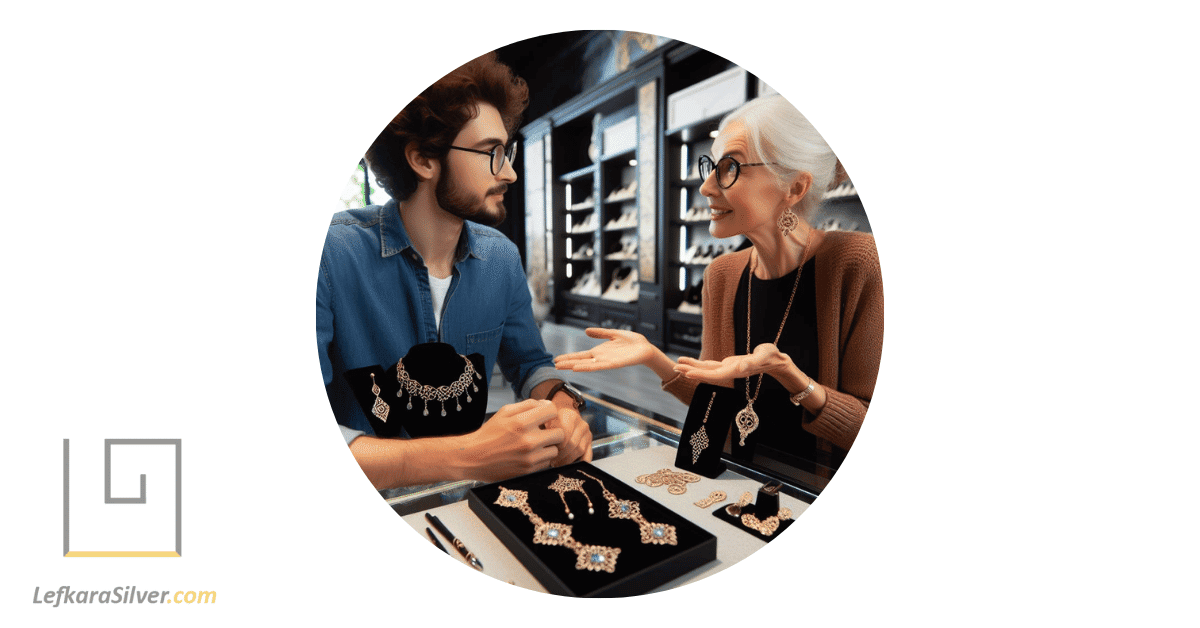
What Is Filigree Jewelry?
Filigree jewelry is a delicate form of metalwork where artisans twist and shape fine threads of precious metal, like gold or silver, into intricate, lace-like patterns. This ancient technique creates an airy, light, and detailed piece, with some handcrafted designs being so intricate that they reflect light beautifully without needing gemstones.
Given its unique, high-craft nature, filigree holds a special place in the global jewelry market, which was valued at over $350 billion in 2023.
How To Make Filigree Jewelry?
Creating filigree jewelry is a meticulous, multi-step process that demands immense patience and skill. An artisan begins by drawing a precious metal into wonderful threads, which are then twisted, coiled, and sometimes flattened.
These prepared threads are carefully bent into shapes like scrolls or loops and painstakingly arranged within a frame, with each contact point being soldered together with a tiny flame to form the final, intricate design. A single, complex handmade piece can take a master jeweler upwards of 50 hours to complete.
What Does Filigree Mean In Jewelry?
The word “filigree” beautifully describes the technique itself, originating from the Latin words filum, meaning “thread,” and granum, meaning “grain.” This directly refers to the two core components of the art form: the fine, twisted metal threads that create the lace-like patterns and the tiny metal beads (grains) that are often soldered at intersections to add texture and detail. This method has been used for millennia, with artisans passing down the fundamental “thread and grain” technique through generations.
What Is The History Of Filigree Jewelry?
The history of filigree is as intricate as its designs, with the earliest known examples dating back more than 5,000 years to ancient Mesopotamia. The technique flourished in ancient Greece and Rome and spread across Asia and Europe, with different cultures adding their own unique motifs.
Filigree saw a major resurgence in popularity during the Edwardian era (1901-1910), when jewelers began using platinum, a metal strong enough to be fashioned into the magnificent and delicate “metal lace” that defined the period’s romantic style.
How To Identify Authentic Filigree Jewelry?
To identify authentic handmade filigree, look closely at the craftsmanship for the subtle imperfections that prove a human touch, as perfectly symmetrical designs often indicate machine manufacturing. Genuine filigree will have clean lines and smooth soldering points, and the twisted wires should show slight variations upon close inspection. For antique silver pieces over 3 grams, look for a “925” stamp, which certifies that the piece is made of sterling silver.
What Makes Filigree Jewelry Unique?
What makes filigree jewelry truly unique is its handcrafted nature, which ensures that no two pieces are ever completely identical, each carrying the personal touch of the artisan. The technique allows for the creation of large, visually impressive pieces that are surprisingly lightweight and comfortable to wear due to their openwork, lace-like construction. This incredible strength-to-weight ratio is a hallmark of the style, allowing for elaborate designs that would be impractically heavy if made from solid metal.
Where Can I Buy Authentic Filigree Jewelry?
For authentic filigree, seeking out specialized jewelers and artisans is your best bet, with many renowned workshops located in regions with rich filigree traditions like Portugal, Malta, and Cyprus.
Online marketplaces like Etsy connect buyers directly with thousands of independent creators, while platforms like NOVICA, in association with National Geographic, feature curated collections from global artisans. Reputable antique and vintage jewelry stores, such as Filigree Jewelers in Minneapolis, are also excellent sources for historical, one-of-a-kind pieces.
What Are Some Famous Examples Of Filigree Jewelry?
While many famous filigree pieces are historical artifacts housed in museums, one of the most iconic and recognizable designs is the Portuguese “Heart of Viana” (Coração de Viana). This emblematic heart-shaped pendant is a symbol of love and a staple of Portuguese culture, with its intricate filigree design being passed down through generations for over 200 years.
Another well-known example is the delicate, lace-like jewelry of the Edwardian era (1901-1910), which is highly sought after by collectors for its romantic motifs and masterful use of platinum.
How Long Does It Take To Make Filigree Jewelry?
The time required to create a piece of filigree jewelry varies dramatically depending on its complexity, size, and the artisan’s skill level. A simple pair of handmade filigree earrings might take 3 to 5 hours to complete from start to finish. However, a large, intricate statement piece like a traditional bridal necklace could require well over 100 hours of meticulous, focused work, showcasing the incredible dedication and patience inherent in this ancient craft.
Can Filigree Jewelry Be Repaired If Damaged?
Yes, filigree jewelry can often be repaired, but it requires a highly skilled jeweler who specializes in this delicate work. Due to the intricate network of fine wires, repairs like re-soldering a broken connection or reshaping a bent section must be done with extreme precision, often using a laser welder to avoid damaging adjacent areas.
It’s crucial to find a professional with experience in filigree, as a standard repair approach can easily cause more harm than good to these lace-like structures.
How To Differentiate Between Real And Fake Filigree Jewelry?
Authentic handmade filigree can be distinguished from mass-produced imitations by examining the details for subtle, human imperfections, as machine-made pieces are often perfectly uniform. Real filigree consists of individually twisted and soldered wires, which you can often see upon close inspection, whereas “fake” filigree is typically cast from a mold, resulting in a solid piece with a less delicate, sometimes blurry appearance.
Additionally, authentic pieces made of precious metals will usually have a hallmark, such as “925” for sterling silver or karat markings for gold.
What Are The Latest Trends In Filigree Jewelry?
Recent trends see a move towards combining traditional filigree techniques with modern, minimalist aesthetics, creating pieces that are intricate yet wearable for everyday. There is also a growing popularity for “maximalist” filigree, featuring bold, oversized earrings and statement necklaces that showcase the full artistry of the craft.
This trend saw a 15% increase in online searches last year. Another key trend is the mixing of metals and the incorporation of colorful, ethically sourced gemstones within the filigree patterns, giving a fresh, contemporary feel to this ancient art form.
